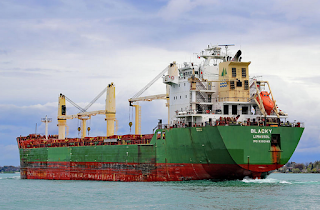Big Ships on the Great Lakes
 I live in Michigan in an area where most freighters and tankers and a few cruise ships sailing on the Great Lakes regularly pass by. A few years ago, I was sitting on a park bench along the boardwalk watching one of these mammoth ships silently glide by not more than 200 feet from where I was sitting, and I said to myself, “Self, you’re a photographer. Why are you not photographing these graceful and majestic vessels?” My self didn’t have an answer.
I live in Michigan in an area where most freighters and tankers and a few cruise ships sailing on the Great Lakes regularly pass by. A few years ago, I was sitting on a park bench along the boardwalk watching one of these mammoth ships silently glide by not more than 200 feet from where I was sitting, and I said to myself, “Self, you’re a photographer. Why are you not photographing these graceful and majestic vessels?” My self didn’t have an answer.So I started photographing them if I happened to have my camera with me while at the boardwalk, but I didn’t really make a concerted effort to shoot as many as possible. After about a year of this haphazard approach, and generally concentrating on other subject matter such as the local hiking trail, architecture and the National Parks, somehow a switch was flipped in my brain, and I found myself obsessed with collecting images of as many of these giants as I could, as well as looking up the basic information about each ship, learning what type of cargo they carry around the Great Lakes and back into the ocean for overseas consumption, noticing the different super-structure types and the types of life boats they carried, etc.
Here are a few facts about these giants of the lakes
- Bulk cargo ships are those that carry loose cargo like grain or mineral and rock products.
- General cargo ships are those that carry containers of goods.
- Tankers carry oil or chemicals.
- Self-unloading ships have cranes to unload their own cargo after docking.
- Tugs - some tugs are called “articulated tugs” which are paired with barges and they can pivot separately from the barge. “Integrated tugs” are tugs rigidly fixed to the barge making the two ships basically one unit. Then there are general free-sailing tugs that are used to assist larger ships.
- Coast Guard ice breakers keep shipping lanes open and help free vessels stuck in the ice, although the shipping season generally shuts down during the winter months.
- Pilot vessels shuttle personnel to and from the larger ships and also deliver mail, etc.
I did watch a Coast Guard cutter free one freighter in town a few years ago. She was stuck in the ice just south of town. She had to wait about four hours for the cutter to arrive and break up the ice, then she was on her way.
Although it’s getting harder and harder to see new ships going through (meaning ships I have never photographed), I’m going to keep at it. As of this writing, I have collected approximately 220 ships comprised of the types listed above.
You can see and purchase any image in my collection here:
https://mary-bedy.pixels.com/collections/freighters+ships+and+boats



Mary, your photographs of these big ships are stunning. Glad you are continuing to photograph them.
ReplyDeleteThanks, Janice! I did just get another one last night. Thanks for dropping by.
DeleteHi Mary Bedy, I have always been impressed with your talents. Not only are you an interpreter of languages (a trait which is amazing) but you have a distinct quality in your online mannerisms. I must confess, I know nothing of your art but I am impressed with the very nature of your responses in certain threads on FAA. The fact that you recognize how important economics are to the health of civilization and are willing to contribute tankers and tugs are to our welfare as I have seen in this blog shows me that you are a person of integrity and a true patriot.
ReplyDelete